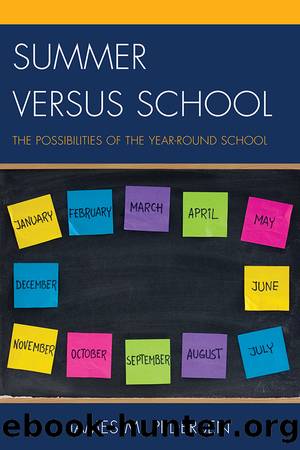Summer versus School by Pedersen James;

Author:Pedersen, James; [Pedersen, James M.]
Language: eng
Format: epub
Publisher: Rowman & Littlefield Publishers
Published: 2014-08-15T00:00:00+00:00
Part II
6
Year-Round Schools around the World
Examples of Nontraditional International School Calendars
Around the World
A reoccurring issue that is often brought up in conversations about school reform today concerns the way American schools measure up against their international peers. In some reports the United States is at best mediocre when compared to the rest of the world (Ryan 2013). In other examples, our schools fare much worseâespecially in math and science.
This is most obvious when compared to countries like Finland, South Korea, and Japan, which have received many accolades for their progressive school systems. Researchers have begun to look to these schools and have found that a longer school year in Asia and Europe is linked to higher achievement (Gewertz 2008).
As American reformers look to find ways to retain their international ranking, one of the things they are looking at is instructional time. Former secretary of education Arne Duncan even stated that students in other countries attended school 25 to 30 percent longer than American students (CPE 2011). This percentage was attributed to the average number of days most high ranked countries useâwhich is around 220âcompared to the American average, which is 180.
At least four east Asian countriesâSingapore, South Korea, Japan, and Hong Kongâhave academic years with more than 200 school days, and these are also the highest-scoring countries on international tests of mathematics skills.
Some Global Comparisons
A large number of schools around the world employ year-round calendars. Some of them have a longer school year while others intersperse their breaks using a balanced calendar (Ballinger and Kneese 2006). In concert with this thinking is examining how other schools around the world spend their summer vacations. Most experts are not necessarily critical of having a summer break, but rather the duration of the break is what is viewed to be detrimental.
Mark Hughes at infoplease.com, an education resource website, compiled a brief list of regions around the world and how they divide their instruction time with breaks; it is good to see how they compare to the United States:
Africa
Kenya: The school year is divided into three terms, each thirteen weeks long, with one-month breaks between. School days are from 8 a.m. to 4 p.m. (Hughes 2014).
Nigeria: The school year runs from January to December and is divided into three semesters with a month off between each semester (Hughes 2014).
Asia
China: The school year in China typically runs from the beginning of September to mid-July. Summer vacation is generally spent in summer classes or studying for entrance exams (Hughes 2014).
Japan: Most Japanese schools run on a trimester schedule with the school year from April to March, with breaks for summer, winter, and spring separating the three terms (Hughes 2014).
South Korea: The school year runs from March to February and is divided into two semesters that are from March to July and September to February (Hughes 2014).
Australia
Students in Australia attend school for 200 days a year that span from January to December. Summer vacation lasts from mid-December to late January. Their school year is divided into four terms, with each term lasting nine to eleven weeks (Hughes 2014).
Download
This site does not store any files on its server. We only index and link to content provided by other sites. Please contact the content providers to delete copyright contents if any and email us, we'll remove relevant links or contents immediately.
Macmillan Primary Grammar 2 Pupil's Book by Unknown(377)
Figuring Out Fluency in Mathematics Teaching and Learning, Grades K-8 by Jennifer M. Bay-Williams & John J. SanGiovanni(342)
The Principal's Guide to Curriculum Leadership by Sorenson Richard D.;Goldsmith Lloyd M.;Mendez Zulma Y.;Maxwell Karen T.;(264)
English Grammar Practice--The Noun by Roxana Nastase(228)
Learning from Accidents 3rd ed by Trevor Kletz (2001)(226)
Harnessing Technology for Deeper Learning by Scott McLeod(214)
Text-Dependent Questions, Grades K-5 by Douglas Fisher & Nancy Frey & Heather Anderson & Marisol Thayre(207)
English Language Program Administration by Unknown(199)
A Guide to Curriculum Mapping by Hale Janet A.;(199)
Deep Change Leadership by Reeves Douglas;(188)
How to Do Everything with Google Tools by Unknown(185)
The Grammar Teacher's Activity-a-Day by Jack Umstatter(177)
The Power of SMART Goals by Conzemius Anne;O'Neill Jan; & Anne Conzemius(175)
Beyond the RTI Pyramid by Bender William N.;(157)
Aligning and Balancing the Standards-Based Curriculum by Squires David A.;(155)
Using Data to Close the Achievement Gap by Johnson Ruth S.;(155)
Using Equity Audits to Create Equitable and Excellent Schools by Skrla Linda E.;McKenzie Kathryn B.;Scheurich James Joseph;(149)
Differentiated Instructional Strategies for the Block Schedule by Gregory Gayle H.;Herndon Lynne E.; & Lynne E. Herndon(139)
You've Got to Reach Them to Teach Them by Schreck Mary Kim; & Schreck(137)
